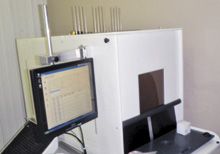Putting memory to the test
The delayed non-matching-to-position task can help assess a dog's ability to learn and remember.
The delayed non-matching-to-position (DNMP) task is a test specifically developed for use in dogs to assess spatial learning, says Bill Milgram, PhD, co-founder of CanCog Technologies in Toronto.
“We wanted to develop a test that requires the dog to learn to respond to a specific location and hold that information in memory,” Milgram says. “Human patients with Alzheimer's disease, for example, may totally lose the ability to function spatially, which is commonly seen when they go for a walk, get lost and can't find their way home.”

The delayed non-matching-to-position task can help assess a dog's ability to learn and remember. Photo courtesy of Bill Milgram, PhD.For the DNMP task, an animal enters a testing box (Figure 1) with three food wells positioned outside the box opening: one to the center, one to the left and one to the right. “In the first phase, we present a food reward in one of the food wells, and we cover that reward with an object covering the food well, thus hiding the food,” says Milgram. “What the animal has to do is remember where the object was when they received the reward (right, left or center). On the second phase of the task, we now test the animal with two identical objects, one at the first location and the second object at a new location. In order for the animal to get rewarded during the second trial, they have to respond to the new location (the location that was different from the location in the first phase). The objects used in the second phase are identical to those used in the first.”
There are two skills involved in completing the task. First, the animal responds to the new location, which assesses learning. Once the animal has completed the learning portion and knows to select the opposite location during the second phase, researchers can test memory. For example, they will present a single object that the dog must remember to choose the opposite location of during the second phase and wait a variable length of time before presenting the object pair. Some animals can hold the information in memory for only a short time (for example, 20 seconds). Other animals can perform accurately with a memory interval of as long as five minutes. “We can therefore use the DNMP task to look at learning and memory. And it's a beautiful test to look at changes in learning ability with increased age,” Milgram says. “As dogs age they perform more and more poorly on this task, which is essentially a ‘biomarker' of age. The older the dog, the slower they learn it, while young dogs can learn very rapidly.”
Similarly, as dogs age they are more likely to fail or perform poorly in the memory portion of the test. “We can then look at modifiers of memory, including diet or various drugs, to see how they enhance their ability to complete the DNMP task,” Milgram states. “For older dogs, as the time is prolonged, their memory is impaired and their ability to properly complete the DNMP task deteriorates sharply. As a basic example, we might assume that while younger dogs can remember where they live and be able to return home from a distance, we would also assume that older dogs would likely become lost like an Alzheimer's patient.”